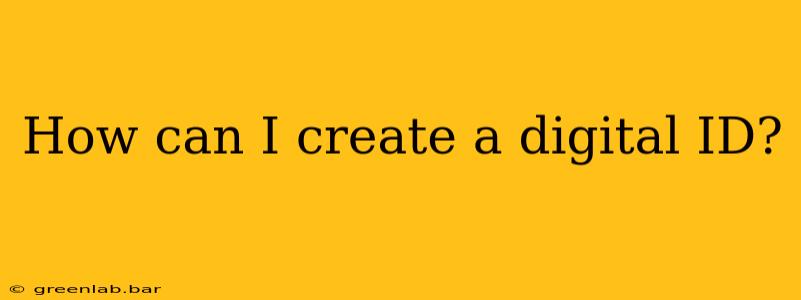The digital world demands a secure online identity, and creating a robust digital ID is crucial for accessing various online services and protecting your personal information. This comprehensive guide will walk you through the process, addressing different types of digital IDs and the security considerations involved.
Understanding Digital IDs: More Than Just a Username
A digital ID isn't simply a username and password; it's a verifiable online identity that proves you are who you say you are. It offers a higher level of security than traditional login methods and enables you to access services securely and efficiently. There are several types of digital IDs, each with its own level of security and verification:
Types of Digital IDs:
-
Username and Password: The most basic form, but highly vulnerable to hacking and phishing. While not a true digital ID in the strictest sense, it's the foundation for many online accounts. Strong passwords and multi-factor authentication (MFA) are crucial here.
-
Email and Phone Number Verification: While not a full digital ID, these methods add an extra layer of security by verifying your contact information. They often serve as a second factor in MFA.
-
Social Media Logins: Using your existing social media accounts for authentication is convenient, but it shares your data with third-party platforms, posing potential privacy risks.
-
Government-Issued Digital IDs: These are increasingly common, offering strong authentication and security features. Examples include digital driver's licenses and national identity cards. These are often issued through government-approved apps or platforms.
-
Software-Based Digital IDs: These rely on cryptographic techniques to verify your identity. They are often used for secure online transactions and access to sensitive data.
Creating Your Digital ID: A Step-by-Step Guide
The process of creating a digital ID varies depending on the type. However, some general principles apply:
1. Choose a Reputable Provider:
Ensure the entity issuing or managing your digital ID is trustworthy and adheres to strict security standards. Look for information on their security measures and privacy policies.
2. Gather Required Information:
Depending on the ID type, you'll need personal information like your name, date of birth, address, and possibly government-issued identification documents.
3. Follow the Specific Instructions:
Each platform or service will have its own process for creating a digital ID. Carefully read the instructions and follow them precisely.
4. Secure Your Digital ID:
Use strong, unique passwords, and enable MFA whenever possible. Regularly update your passwords and be vigilant about phishing attempts.
5. Monitor Your Account Activity:
Regularly check your account for unauthorized activity. Set up alerts to notify you of any suspicious login attempts.
Securing Your Digital Identity: Best Practices
Protecting your digital identity requires ongoing vigilance. Consider these practices:
- Use strong, unique passwords: Avoid reusing passwords across different accounts. Use a password manager to help you create and manage secure passwords.
- Enable multi-factor authentication (MFA): This adds an extra layer of security by requiring a second form of verification, such as a code sent to your phone or email.
- Be wary of phishing scams: Don't click on suspicious links or open emails from unknown senders.
- Keep your software updated: Regularly update your operating system and software to patch security vulnerabilities.
- Use antivirus software: Protect your devices from malware and viruses that could compromise your digital identity.
- Monitor your credit report: Regularly check your credit report for any unauthorized activity.
Conclusion: Embracing a Secure Digital Future
Creating and maintaining a secure digital ID is essential in today's interconnected world. By understanding the different types of digital IDs, choosing reputable providers, and following best security practices, you can protect your online identity and enjoy the benefits of seamless and secure online access. Remember, your digital identity is a valuable asset—protect it accordingly.

